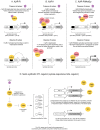D-Xylose Sensing in Saccharomyces cerevisiae: Insights from D-Glucose Signaling and Native D-Xylose Utilizers
- PMID: 34830296
- PMCID: PMC8625115
- DOI: 10.3390/ijms222212410
D-Xylose Sensing in Saccharomyces cerevisiae: Insights from D-Glucose Signaling and Native D-Xylose Utilizers
Abstract
Extension of the substrate range is among one of the metabolic engineering goals for microorganisms used in biotechnological processes because it enables the use of a wide range of raw materials as substrates. One of the most prominent examples is the engineering of baker's yeast Saccharomyces cerevisiae for the utilization of d-xylose, a five-carbon sugar found in high abundance in lignocellulosic biomass and a key substrate to achieve good process economy in chemical production from renewable and non-edible plant feedstocks. Despite many excellent engineering strategies that have allowed recombinant S. cerevisiae to ferment d-xylose to ethanol at high yields, the consumption rate of d-xylose is still significantly lower than that of its preferred sugar d-glucose. In mixed d-glucose/d-xylose cultivations, d-xylose is only utilized after d-glucose depletion, which leads to prolonged process times and added costs. Due to this limitation, the response on d-xylose in the native sugar signaling pathways has emerged as a promising next-level engineering target. Here we review the current status of the knowledge of the response of S. cerevisiae signaling pathways to d-xylose. To do this, we first summarize the response of the native sensing and signaling pathways in S. cerevisiae to d-glucose (the preferred sugar of the yeast). Using the d-glucose case as a point of reference, we then proceed to discuss the known signaling response to d-xylose in S. cerevisiae and current attempts of improving the response by signaling engineering using native targets and synthetic (non-native) regulatory circuits.
Keywords: Saccharomyces cerevisiae; d-xylose; non-native substrate; signaling network engineering; sugar sensing; sugar signaling; synthetic signaling circuits.
Conflict of interest statement
The authors declare that they have no competing interests.
Figures







Similar articles
-
In-situ muconic acid extraction reveals sugar consumption bottleneck in a xylose-utilizing Saccharomyces cerevisiae strain.Microb Cell Fact. 2021 Jun 7;20(1):114. doi: 10.1186/s12934-021-01594-3. Microb Cell Fact. 2021. PMID: 34098954 Free PMC article.
-
Genome-scale consequences of cofactor balancing in engineered pentose utilization pathways in Saccharomyces cerevisiae.PLoS One. 2011;6(11):e27316. doi: 10.1371/journal.pone.0027316. Epub 2011 Nov 4. PLoS One. 2011. PMID: 22076150 Free PMC article.
-
Exploring the xylose paradox in Saccharomyces cerevisiae through in vivo sugar signalomics of targeted deletants.Microb Cell Fact. 2019 May 23;18(1):88. doi: 10.1186/s12934-019-1141-x. Microb Cell Fact. 2019. PMID: 31122246 Free PMC article.
-
Engineering of Saccharomyces cerevisiae for the efficient co-utilization of glucose and xylose.FEMS Yeast Res. 2017 Jun 1;17(4). doi: 10.1093/femsyr/fox034. FEMS Yeast Res. 2017. PMID: 28582494 Review.
-
Production of fuels and chemicals from xylose by engineered Saccharomyces cerevisiae: a review and perspective.Microb Cell Fact. 2017 May 11;16(1):82. doi: 10.1186/s12934-017-0694-9. Microb Cell Fact. 2017. PMID: 28494761 Free PMC article. Review.
Cited by
-
Impact of xylose epimerase on sugar assimilation and sensing in recombinant Saccharomyces cerevisiae carrying different xylose-utilization pathways.Biotechnol Biofuels Bioprod. 2023 Nov 6;16(1):168. doi: 10.1186/s13068-023-02422-z. Biotechnol Biofuels Bioprod. 2023. PMID: 37932829 Free PMC article.
-
D-xylose accelerated death of pentose metabolizing Saccharomyces cerevisiae.Biotechnol Biofuels Bioprod. 2023 Apr 17;16(1):67. doi: 10.1186/s13068-023-02320-4. Biotechnol Biofuels Bioprod. 2023. PMID: 37069654 Free PMC article.
-
Glucose receptor deletion and engineering: impact on xylose sensing and utilization in Saccharomyces cerevisiae.FEMS Yeast Res. 2025 Jan 30;25:foaf040. doi: 10.1093/femsyr/foaf040. FEMS Yeast Res. 2025. PMID: 40728911 Free PMC article.
-
The role of ATP citrate lyase, phosphoketolase, and malic enzyme in oleaginous Rhodotorula toruloides.Appl Microbiol Biotechnol. 2025 Mar 29;109(1):77. doi: 10.1007/s00253-025-13454-w. Appl Microbiol Biotechnol. 2025. PMID: 40156749 Free PMC article.
-
Profiling proteomic responses to hexokinase-II depletion in terpene-producing Saccharomyces cerevisiae.Eng Microbiol. 2023 Apr 3;3(3):100079. doi: 10.1016/j.engmic.2023.100079. eCollection 2023 Sep. Eng Microbiol. 2023. PMID: 39628925 Free PMC article.
References
-
- Abril M.A., Michan C., Timmis K.N., Ramos J.L. Regulator and Enzyme Specificities of the Tol Plasmid-Encoded Upper Pathway for Degradation of Aromatic-Hydrocarbons and Expansion of the Substrate Range of the Pathway. J. Bacteriol. 1989;171:6782–6790. doi: 10.1128/jb.171.12.6782-6790.1989. - DOI - PMC - PubMed
-
- Klemba M., Jakobs B., Wittich R.M., Pieper D. Chromosomal integration of tcb chlorocatechol degradation pathway genes as a means of expanding the growth substrate range of bacteria to include haloaromatics. Appl. Environ. Microbiol. 2000;66:3255–3261. doi: 10.1128/AEM.66.8.3255-3261.2000. - DOI - PMC - PubMed
Publication types
MeSH terms
Substances
Grants and funding
LinkOut - more resources
Full Text Sources
Molecular Biology Databases

